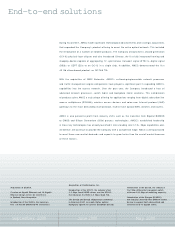3Ware 2001 Annual Report Download - page 12
Download and view the complete annual report
Please find page 12 of the 2001 3Ware annual report below. You can navigate through the pages in the report by either clicking on the pages listed below, or by using the keyword search tool below to find specific information within the annual report.
10
Glossary
ASIC (APPLICATION-SPECIFIC INTEGRATED CIRCUIT)An integrated
circuit custom designed for a specific application or to perform
specific tasks.
ASSP (APPLICATION-SPECIFIC STANDARD PRODUCT)An integrated
circuit that, like an ASIC, performs functions for a specific applica-
tion or task but is offered “off the shelf” as a standard, commercial
product.
ATM (ASYNCHRONOUS TRANSFER MODE)Very high-speed
transmission technology. ATM is a high-bandwidth, low-delay,
connection-oriented, cell-based (fixed-length data units) switching/
multiplexing technique.
BACKPLANE The physical area, usually at the rear of the electron-
ics frame, where modules and cables plug into the system.
BICMOS A process that combines the speed of bipolar technology
with the low power capability of CMOS technology.
BIPOLAR A process technology that employs silicon as the sub-
strate upon which to fabricate circuits. The circuits are based on
fast-switching bipolar transistor structures.
CEPT European standards-setting body that defines how the bits of
a PCM carrier system of the 32-channel European type T-1/ E-1 will
be used and in what sequence.
CMOS (COMPLEMENTARY METAL OXIDE SEMICONDUCTOR)
A process technology that employs silicon as the substrate
upon which to fabricate circuits. The CMOS IC design is based on
MOS Field Effect Transistor (FET) structures and features low power
consumption and small component dimensions.
DATA COMMUNICATIONS The transfer of encoded information over
electrical or optical transmission systems between points.
DS (DIGITAL SIGNAL)A hierarchy of digital signal speeds used to
classify the capacities of lines and trunks. The fundamental speed
level is DS-0 (64 kilobits per second) and the highest is DS-4 (about
274 million bits per second).
DSLAM (DIGITAL SUBSCRIBER LINE ACCESS MULTIPLEXER)Used
to receive multiple users’ DSL signals, multiplex them together
using ATM, IP or Frame Relay and transmit multiplexed signal to the
WAN. Usually located at a telephone company’s central office.
FEC (FORWARD ERROR CORRECTION)A system of data transmission
in which redundant bits generated at the transmitted end are used
at the receiving end to detect, locate and correct any transmission
errors before delivery to the data communications link.
FIBRE CHANNEL A set of standards developed by ANSI (American
National Standards Institute). Fibre Channel provides a practical
and inexpensive means of rapidly transferring data between work-
stations, mainframes, supercomputers, desktop computers,
storage devices, displays and other peripherals.
FRAMER A device that adjusts the timing of the receiver component
to coincide with that of the receiving framing signals.
GBPS Gigabits per second.
IC (INTEGRATED CIRCUIT)A chip etched or imprinted with a network
of electronic components.
LTV (LIFETIME VALUE)The total dollar value of a design win is
estimated by determining the number of units expected to ship over
the lifetime of the product for that opportunity multiplied by the
average selling price over that period.
MAN (METROPOLITAN AREA NETWORK)A high-speed data, intra-city
network that links multiple locations within a campus, city or LATA.
MIXED-SIGNAL IC Monolithic ICs that contain both digital and
analog circuitry.
MPLS (MULTI-PROTOCOL LABEL SWITCHING)Used to increase the
speed of network traffic flow by inserting the information about
a specific path the packet takes to its destination. This saves time
needed for a router to look up the address for the next node
to which the packet is supposed to be sent. MPLS works with
IP, ATM and Frame Relay communications methods.
NPU (NETWORK PROCESSOR) A software-programmable micro-
processor optimized for networking and communications functions.
It presents network equipment vendors with an off-the-shelf alterna-
tive for building routers, switches and access devices offering
faster time-to-market versus designing a custom ASIC chip.
Customers may program an NPU to perform classification analy-
sis, modification and forwarding of incoming data packets/ cells,
as well as identifying and enforcing security and quality of service
rules. MMC Networks coined the term in 1997.
OC-48,-192,-768 (OPTICAL CARRIER LEVEL-48,-192,-768)
A SONET optical signal. SONET data rates of 2.5 Gbps, 10 Gbps
and 40 Gbps, respectively.
PHY PHYsical, as in physical specifications. OSI Physical Layer:
The physical layer provides for transmission of cells over a physical
medium connecting two ATM devices. This layer is comprised of two
sublayers: PMD (see below) and TC (Transmission Convergence).
PMD (PHYSICAL MEDIA DEPENDENT)The sublayer defining
the parameters at the lowest level, i.e.,speed of the bits on the media.
SDH (SYNCHRONOUS DIGITAL HIERARCHY)A set of standard fiber
optic–based serial standards very similar to SONET used through-
out the world except in North America and Japan.
SERDES (SERIALIZER/DESERIALIZER)Technology that changes
data from parallel-by-byte to serial-by-bit and back again.
SIGE(SILICON GERMANIUM)A process technology that employs
a Germanium-doped silicon substrate upon which to fabricate
circuits. This enables much higher data rates than are possible with
traditional silicon processes.
SILICON Traditional semiconducting material used for fabricating ICs.
SONET (SYNCHRONOUS OPTICAL NETWORK)An optical interface
standard used in North America and Japan that allows interoper-
ability of transmission products from multiple vendors very similar
to SDH. The standard specifies a family of fiber-optic transmission
rates from 52 Mbps to 10 Gbps, created to provide the flexibility
needed to transport many digital signals with different capacities
and to provide a design standard for manufacturers.
STS (SYNCHRONOUS TRANSPORT SIGNAL)The electrical equivalent
of SONET OC level. The signal begins as electrical and is converted
into optical prior to presentation to the fiber optic medium.
SWITCH FABRIC A chip, or set of chips, used as the central, high-
speed interconnection among multiple ports in a networking
platform. Typically, a switch fabric passes traffic among packet- or
cell-processing chipsets, whether ASICs or off-the-shelf network
processors and traffic managers.
TELECOMMUNICATIONS The transmission, reception and the
switching of signals, such as electrical or optical, by wire, fiber or
electromagnetic means.
TIA (TRANSIMPEDENCE AMPLIFIER)Used to improve the performance
of a detector in a fiber-optic system. The TIA takes the photo-
diode output current, multiplies it by the transimpedance gain
and outputs a voltage signal.
TRAFFIC MANAGER A chip, or set of chips, in a networking plat-
form used to implement Quality of Service policies, including the
provisioning of bandwidth (both guaranteed minimums and enforced
maximums) to individual users/ subscribers, flow control, etc.
VOIP (VOICE OVER INTERNET PROTOCOL)Technology that enables
devices of disparate manufacture to support voice communications
over packet networks such as the Internet.
























